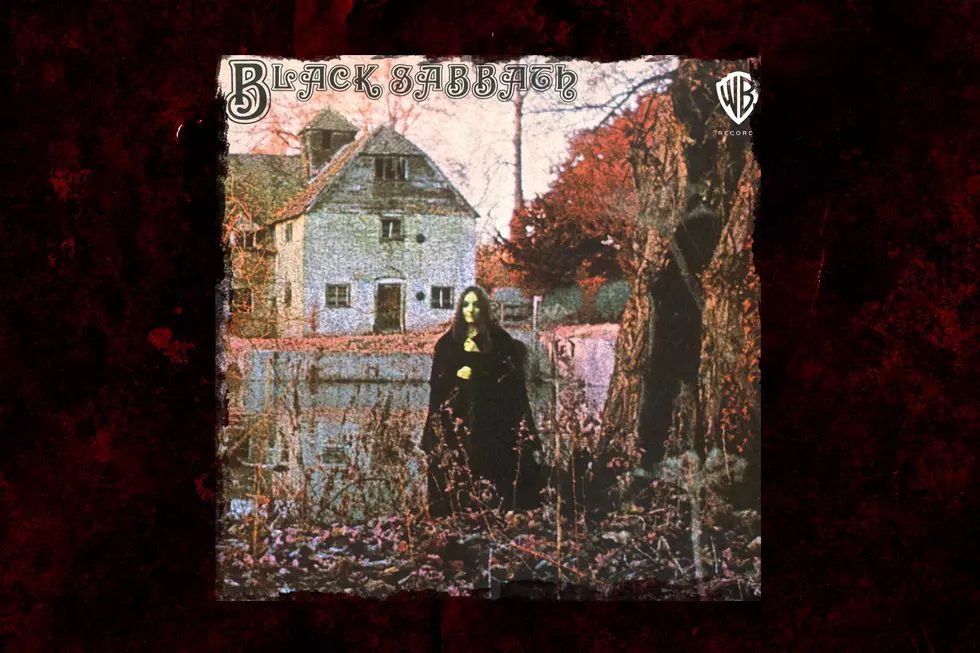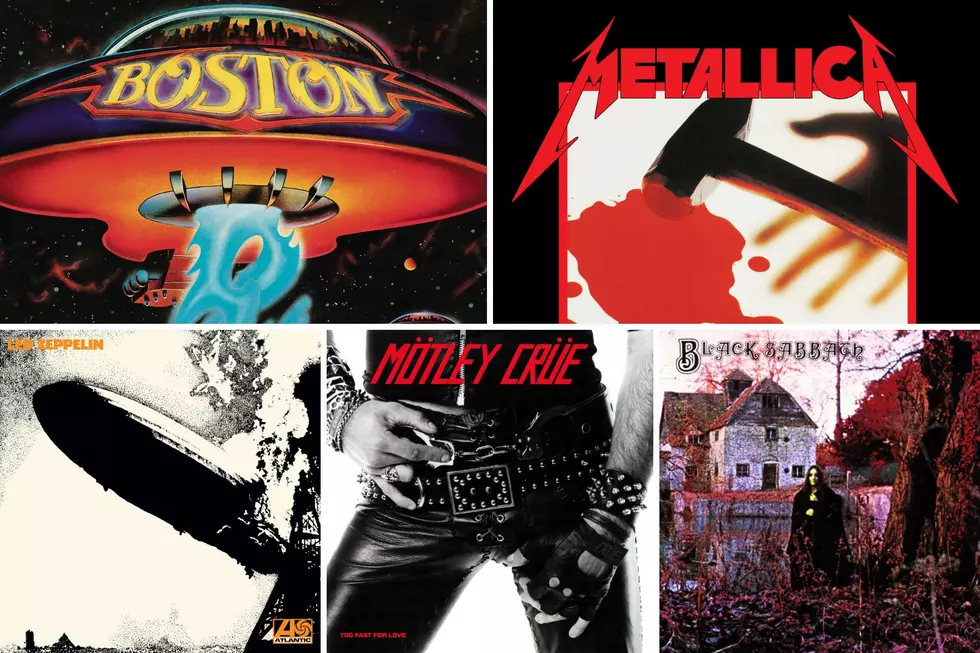
54 Years Ago: Black Sabbath Release Their Debut Album + Invent Heavy Metal
Happy anniversary to Black Sabbath's self-titled metal-defining debut album.
It was a clarion call that echoed from the void, a raucous cry of unity for rockers that couldn’t relate to the peace and love vibes of the Woodstock era. The sound had less to do with the escapist tone of most popular music and more to do with the desperation and frustration of living in the detritus of post-World War II Europe.
The eponymous album by Black Sabbath, which was released in Europe on February 13, 1970, and in North America on June 1 of the same year, was like nothing hard rock fans had ever heard. There were elements of Led Zeppelin and Cream in there, sure, but the music was grimmer and far less euphoric.
Instead of flaunting exuberant energy, Sabbath focused on the bleak and barren, confronting listeners with buzzing, overdriven guitars, meandering bass, lumbering beats and nasal, almost sepulchral vocals that sliced through the organized cacophony like a scalpel through a corpse. It was loud, it was weird and, for many, it was almost an overwhelming sensory overload.
Black Sabbath, "Black Sabbath"
Black Sabbath started with atmospheric sound effects and then guitarist Tony Iommi launched into one of metal’s most influential licks, the devil’s tritone – a dissonant, unsettling configuration allegedly once banned by the church and shunned by composers. Rarely was the tritone heard in popular music; it was most often heard along with the haunting noises in horror film soundtracks. Yet Black Sabbath relished the uneasy feeling the repeated three-note passage engendered.
Anthrax guitarist Scott Ian first heard it when he was a kid listening to his uncle’s stereo and the experience left an indelible imprint on his brain. “I just sat there scared,” he says. “From the start, I was listening to the rain and the wind and the bell and then that riff started and just blew my mind.”
Disturbed frontman David Draiman had a similar experience years later when, during a game of "Dungeons & Dragons," his friend put Black Sabbath on the turntable. “They just brought a vibe and a feel that no other band on the planet ever tried to do,” he says. “Before them, no one played those notes and no one played these doomy riffs with that sludgy, heavy sound.”
Other heavy artists — including Blue Cheer, The Stooges and Jimi Hendrix — had dipped their toes into the gut-twisting morass of chords and notes that was to become heavy metal, but Black Sabbath were the first to capture the sound, vibe and attitude that defined the genre.
Who Really Invented Heavy Metal?
Over the next five years they recorded five of the most influential and essential metal albums ever, but Black Sabbath was truly groundbreaking — a structurally complete blueprint for doom. Even the cover art foreshowed the originality within. The strange, unsettling image of a plain-looking woman (a witch, perhaps?) standing in the woods in front of a farmhouse contained no occult symbols or violent imagery, yet it was as disturbing as the original cover of The Beatles’ Yesterday and Today. The shot was taken at the Mapledurham Watermill in Oxfordshire, England and it remains one of metal’s iconic images.
The Beatles, Yesterday and Today
For such a seminal album, Black Sabbath was practically an afterthought for Fontana Records, which booked the band a single day in the studio, October 16, 1969, to record with beginner producer Rodger Bain and engineer Tom Allom at Regent Sound Studios in London.
After the album was tracked the label washed their hands of it, shuffling Sabbath’s debut to Vertigo Records. Just being in the studio was an exciting opportunity for Black Sabbath, which started as a 12-bar blues band called Earth before changing their name, and the musicians were eager to prove themselves.
As Earth, they had tested crowds with the songs “Black Sabbath” and “Wicked World” and the reactions were promising. “That was the first time that people started looking up and going, ‘Wow, what’s this?’ says Iommi. “They’d come up afterwards and say, ‘What were those songs? We really liked those.’”
Earth, 1969 Demo (Pre-Black Sabbath)
As soon as Earth decided to stray from their blues roots, they expanded upon their new sound with a batch of dense, equally textural tracks, including “N.I.B.” and “Behind the Wall of Sleep” and rehearsed them until they could play them from start to finish, time and again. They were tight, they were heavy and they were ready to transform rock 'n' roll in a day.
“We went in the studio and we were off from the word go,” Iommi recalls. “It’s hard to even remember the session. One second we were playing these songs and then the next thing we knew we were out of there. Some people think the album was recorded in a haze of drugs, but we hadn’t discovered that yet and we didn’t have time to get stoned. We had one day to prove ourselves, and that’s what we did.”
“We literally went in and played as if it was a live gig,” adds Butler. “We didn’t know anything about studios or production or engineering. We just went in, set up and played and they recorded us. It sounds easy, but it’s actually a really hard thing to do – to record a band live in the studio and get the whole feeling across. A lot of producers tried that but dismally failed. But Roger and Tom just had the knack of doing it.”
Aside from the cult Chicago band Coven, which wrote Satanic lyrics and included a recording of a black mass on their 1969 album Witchcraft Destroys Minds & Reaps Souls, Black Sabbath were the first group to write songs that mentioned Lucifer and Satan and featured occult themes. To a large extent, Sabbath knew they were playing with fire and enjoyed being provocative. And they wrote from a knowledgeable perspective since they had dabbled in occult rituals and readings.
Coven, Witchcraft Destroys Minds & Reaps Souls
“We were into it,” Iommi says. “Certainly [bassist] Geezer [Butler] and myself were. It was certainly an interest. There was this thing called ‘the occult’ and we wanted to soak in as much as we could about it and find out what it was about. I suppose we got wrapped up a bit too much sometimes.”
Black Sabbath didn’t exclusively write about darkness and evil and they stopped short of endorsing the occult. “Black Sabbath,” which is often referenced for its blatantly Satanic lyrics, was actually written by Ozzy Osbourne and was based on a paranormal experience Butler had one night.
“In the middle of the night I felt this presence,” Butler told Louder Than Hell: The Definitive Oral History of Metal. “I woke up and there was this black shape looming over the bottom of the bed. It frightened the pissing life out of me. I told Ozzy and that inspired him to write the lyrics to the song as a warning to people that were getting heavily involved in black magic.”
READ MORE: 30 Bands Names Taken From Classic Rock Songs
Considering the band’s name, it’s not hard to grasp how Satanists misunderstood the meaning of some of Black Sabbath’s lyrics and assumed the musicians shared their blasphemous views. Despite their interest in black magic, Sabbath were hardly devil worshippers.
In response to vocal and vehement adoration from witches and Satanists, Black Sabbath mocked them in interviews and started wearing large crosses around their necks at the suggestion of the head white witch in England. Sabbath’s response pissed off disciples of Satan. At the same time, the band’ s dark imagery incensed parents and religious figures, neither of whom stopped to consider that Black Sabbath’s lyrics didn’t endorse Satanism.
“There was one incident where we were due to play in a town and we got banned by the church,” Iommi says. “The show was announced in all the papers for two weeks before we got there. The church managed to ban us. And then the bloody church burned down and we got the blame. They were trying to say that we had caused it, which was just weird.”
It’s no surprise that most of the mainstream press didn’t cater to Black Sabbath’s charms, labeling them primitive and untalented. “They thought our music was for yobs and doubters,” Iommi says. “They didn’t see it as music at all.”
That didn’t stop hard rock fans from reacting to the band’s trailblazing music. Not long after its Friday the 13th release, Black Sabbath was No. 8 in the U.K. album charts. And when the record came out in North America three-and-a-half months later, it climbed to No. 23 on Billboard and remained on the chart for a year, chalking up more than a million album sales.
“We built up our reputation through word of mouth,” Iommi says. “Every time we’d play in clubs [in Europe], we’d see more and more people coming to the show. Little pockets would build up and then eventually they became big pockets. Then, when the album got in the charts in the U.S., we could say, ‘Look what we’ve done,’ and more people started to check us out and if they liked it they brought in their friends. It became this ever-evolving thing.”
The U.K. release of Black Sabbath featured two cover tunes, Crow’s “Evil Woman” (which was previously released as a single that also contained “Wicked World”) and Aynsley Dunbar Retaliation’s “Warning.” The U.S. release removed “Evil Woman” and blended “Behind the Wall of Sleep” into a single track that also included “N.I.B.” and the U.S.-only cuts “Wasp” and “Basically.” The original U.S. version also merged “Warning” into a medley that also featured “A Bit of Finger” (U.S.-only) and “Sleeping Village.”
Black Sabbath, "Evil Woman"
Through the decades, Black Sabbath has been repackaged and re-released numerous times with previously unreleased songs, outtakes and alternate and instrumental versions. Most recently, the album was remastered and issued in 2016 as a two-CD deluxe edition. The recurring reissues are hardly surprising and, maybe, less of a cash grab than an effort to keep the album vital. There wasn’t a band around in 1970 that was as heavy as Black Sabbath and after the influence of their debut is incalculable.
50 years after its release, Black Sabbath remains a must-have for any metal collection.
“They wrote the playbook for heavy metal,” Scott Ian says. “That's where every riff ever written comes from. Tony Iommi is the guy responsible for all of this.”
These days, Butler is far too much of a polite English gentleman to brag about Black Sabbath being the most important metal record of all time, but he concedes that he considers it the band’s greatest achievement.
“The odds were completely against us when we did the album,” he says. “Nobody wanted to give us a chance. Nobody wanted to manage us. Our families didn’t believe in us. But we persisted. And we made this album that we liked and, apparently, loads of other people liked. For us, it was the beginning of an incredible ride.”
Loudwire contributor Jon Wiederhorn is the author of Raising Hell: Backstage Tales From the Lives of Metal Legends, co-author of Louder Than Hell: The Definitive Oral History of Metal, as well as the co-author of Scott Ian’s autobiography, I’m the Man: The Story of That Guy From Anthrax, and Al Jourgensen’s autobiography, Ministry: The Lost Gospels According to Al Jourgensen and the Agnostic Front book My Riot! Grit, Guts and Glory.
Farewell Tours That Were Actually Farewell Tours
Gallery Credit: Chad Childers, Loudwire
More From Loudwire









